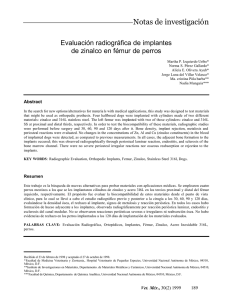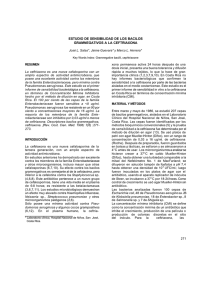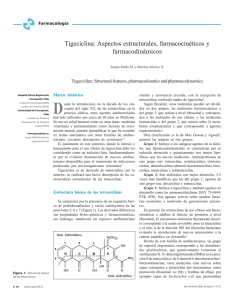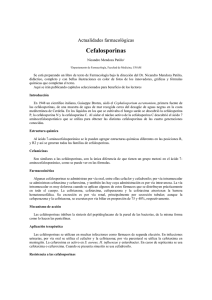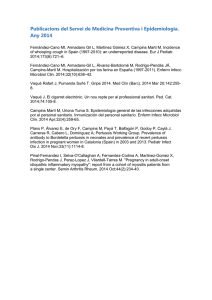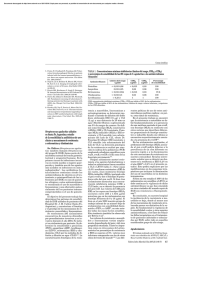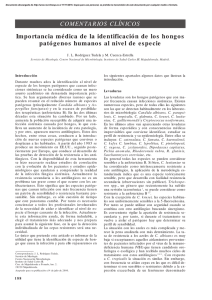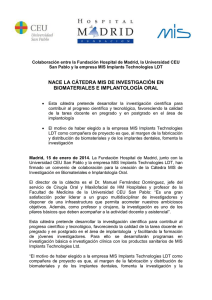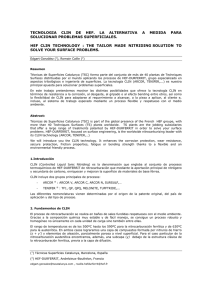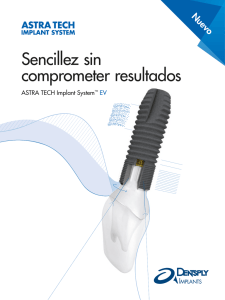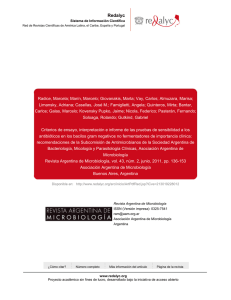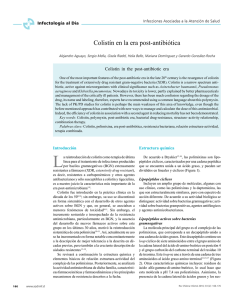Descargar PDF
Anuncio
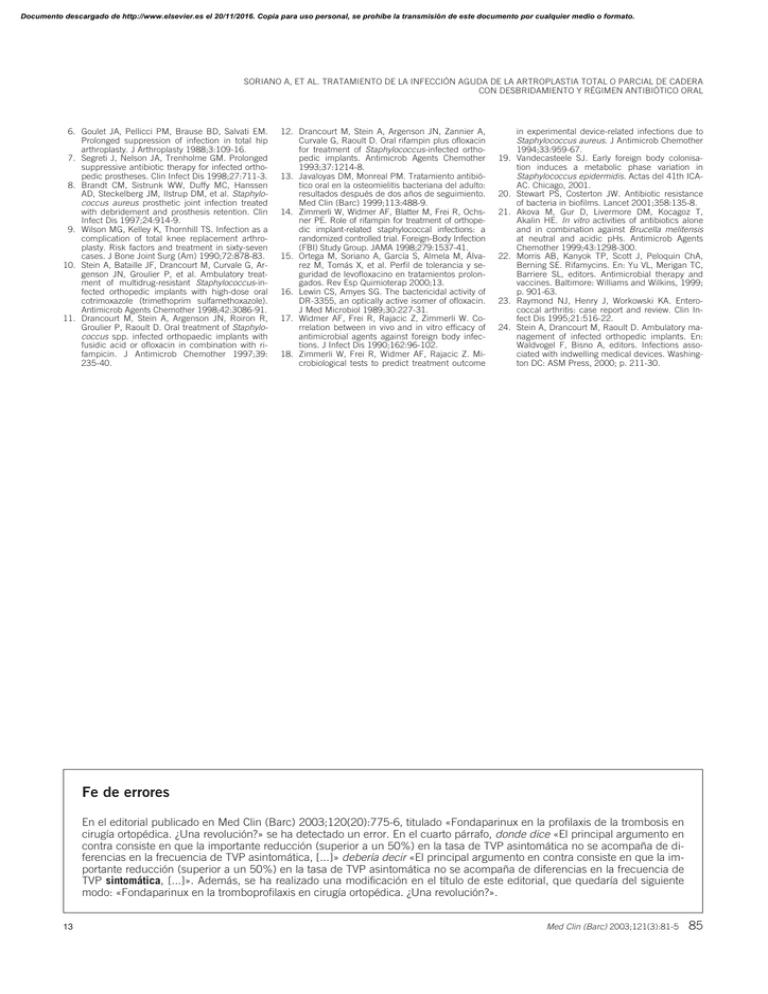
Documento descargado de http://www.elsevier.es el 20/11/2016. Copia para uso personal, se prohíbe la transmisión de este documento por cualquier medio o formato. SORIANO A, ET AL. TRATAMIENTO DE LA INFECCIÓN AGUDA DE LA ARTROPLASTIA TOTAL O PARCIAL DE CADERA CON DESBRIDAMIENTO Y RÉGIMEN ANTIBIÓTICO ORAL 6. Goulet JA, Pellicci PM, Brause BD, Salvati EM. Prolonged suppression of infection in total hip arthroplasty. J Arthroplasty 1988;3:109-16. 7. Segreti J, Nelson JA, Trenholme GM. Prolonged suppressive antibiotic therapy for infected orthopedic prostheses. Clin Infect Dis 1998;27:711-3. 8. Brandt CM, Sistrunk WW, Duffy MC, Hanssen AD, Steckelberg JM, Ilstrup DM, et al. Staphylococcus aureus prosthetic joint infection treated with debridement and prosthesis retention. Clin Infect Dis 1997;24:914-9. 9. Wilson MG, Kelley K, Thornhill TS. Infection as a complication of total knee replacement arthroplasty. Risk factors and treatment in sixty-seven cases. J Bone Joint Surg (Am) 1990;72:878-83. 10. Stein A, Bataille JF, Drancourt M, Curvale G, Argenson JN, Groulier P, et al. Ambulatory treatment of multidrug-resistant Staphylococcus-infected orthopedic implants with high-dose oral cotrimoxazole (trimethoprim sulfamethoxazole). Antimicrob Agents Chemother 1998;42:3086-91. 11. Drancourt M, Stein A, Argenson JN, Roiron R, Groulier P, Raoult D. Oral treatment of Staphylococcus spp. infected orthopaedic implants with fusidic acid or ofloxacin in combination with rifampicin. J Antimicrob Chemother 1997;39: 235-40. 12. Drancourt M, Stein A, Argenson JN, Zannier A, Curvale G, Raoult D. Oral rifampin plus ofloxacin for treatment of Staphylococcus-infected orthopedic implants. Antimicrob Agents Chemother 1993;37:1214-8. 13. Javaloyas DM, Monreal PM. Tratamiento antibiótico oral en la osteomielitis bacteriana del adulto: resultados después de dos años de seguimiento. Med Clin (Barc) 1999;113:488-9. 14. Zimmerli W, Widmer AF, Blatter M, Frei R, Ochsner PE. Role of rifampin for treatment of orthopedic implant-related staphylococcal infections: a randomized controlled trial. Foreign-Body Infection (FBI) Study Group. JAMA 1998;279:1537-41. 15. Ortega M, Soriano A, García S, Almela M, Álvarez M, Tomás X, et al. Perfil de tolerancia y seguridad de levofloxacino en tratamientos prolongados. Rev Esp Quimioterap 2000;13. 16. Lewin CS, Amyes SG. The bactericidal activity of DR-3355, an optically active isomer of ofloxacin. J Med Microbiol 1989;30:227-31. 17. Widmer AF, Frei R, Rajacic Z, Zimmerli W. Correlation between in vivo and in vitro efficacy of antimicrobial agents against foreign body infections. J Infect Dis 1990;162:96-102. 18. Zimmerli W, Frei R, Widmer AF, Rajacic Z. Microbiological tests to predict treatment outcome 19. 20. 21. 22. 23. 24. in experimental device-related infections due to Staphylococcus aureus. J Antimicrob Chemother 1994;33:959-67. Vandecasteele SJ. Early foreign body colonisation induces a metabolic phase variation in Staphylococcus epidermidis. Actas del 41th ICAAC. Chicago, 2001. Stewart PS, Costerton JW. Antibiotic resistance of bacteria in biofilms. Lancet 2001;358:135-8. Akova M, Gur D, Livermore DM, Kocagoz T, Akalin HE. In vitro activities of antibiotics alone and in combination against Brucella melitensis at neutral and acidic pHs. Antimicrob Agents Chemother 1999;43:1298-300. Morris AB, Kanyok TP, Scott J, Peloquin ChA, Berning SE. Rifamycins. En: Yu VL, Merigan TC, Barriere SL, editors. Antimicrobial therapy and vaccines. Baltimore: Williams and Wilkins, 1999; p. 901-63. Raymond NJ, Henry J, Workowski KA. Enterococcal arthritis: case report and review. Clin Infect Dis 1995;21:516-22. Stein A, Drancourt M, Raoult D. Ambulatory management of infected orthopedic implants. En: Waldvogel F, Bisno A, editors. Infections associated with indwelling medical devices. Washington DC: ASM Press, 2000; p. 211-30. Fe de errores En el editorial publicado en Med Clin (Barc) 2003;120(20):775-6, titulado «Fondaparinux en la profilaxis de la trombosis en cirugía ortopédica. ¿Una revolución?» se ha detectado un error. En el cuarto párrafo, donde dice «El principal argumento en contra consiste en que la importante reducción (superior a un 50%) en la tasa de TVP asintomática no se acompaña de diferencias en la frecuencia de TVP asintomática, [...]» debería decir «El principal argumento en contra consiste en que la importante reducción (superior a un 50%) en la tasa de TVP asintomática no se acompaña de diferencias en la frecuencia de TVP sintomática, [...]». Además, se ha realizado una modificación en el título de este editorial, que quedaría del siguiente modo: «Fondaparinux en la tromboprofilaxis en cirugía ortopédica. ¿Una revolución?». 13 Med Clin (Barc) 2003;121(3):81-5 85
